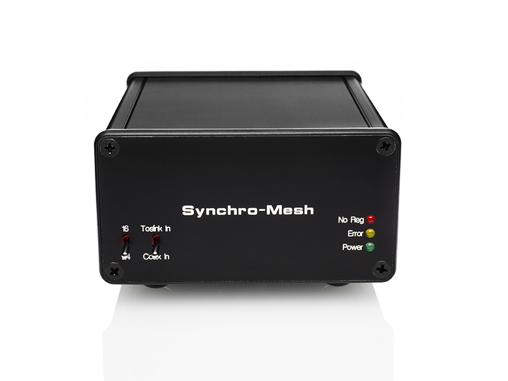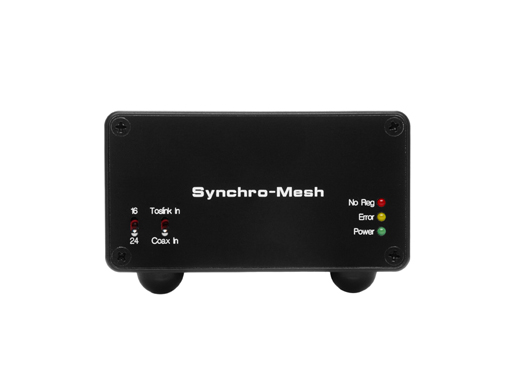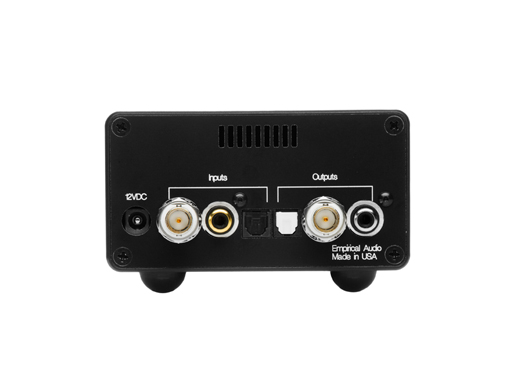30-day money-back guarantee, less shipping and any fees.
Empirical Audio Synchro-Mesh, now with latest generation Crystek clock
The Synchro-Mesh provides a method to improve the sound quality of virtually any 2-channel PCM digital audio source without needing modifications to the source device. It inserts between the source device and the DAC, SS processor or SS Receiver. No drivers are required. An additional digital cable is required.
The Synchro-Mesh has both coax and Toslink optical inputs and outputs. If you have two sources you want to improve, you can connect both of these to the Synchro-Mesh inputs (one coax and the other Toslink) and select between them with the front-panel toggle switch.
Devices that can benefit from the Synchro-Mesh include:
- Squeezebox, all versions
- Sonos
- CD Transports
- Apple TV
- Music Servers
- AirPort Express
- Mac computers with Toslink output
- PCs with S/PDIF or Toslink output
- iPod/Wadia iTransport
- PC PCI cards
- Smart TV feeding 2-channel audio system
Audio quality is improved by reclocking or logically replacing the source clock with the clock inside the Synchro-Mesh. This clock has lower jitter than almost any source device, so the result is a improved clarity, imaging, dynamics and bass impact. The output of the Synchro-Mesh, because it resamples, is not bit-perfect (matching the original source data). Many audiophiles have a hang-up with this, but it is unfounded. Many customers have told us that the resampling is not the issue but instead jitter, in fact they have returned other products to us with similar jitter specs that did not resample because they could not hear the difference between the low-jitter resampled signal of the Synchro-Mesh and the same native sample-rate low-jitter signal. They kept the Synchro-Mesh because it is such a great value. Here is a direct jitter measurement of the Synchro-Mesh/OTL reclocking a Sonos Connect:
~7psec of jitter. Unprecedented in the audio business. This is a result of proprietary techniques and parts that Empirical Audio has been developing for 22 years. No other audio company has the magic recipe to achieve such low jitter, nor do they have the ideal S/PDIF coax output circuit that we have. You will not find ANY device on the market that outputs Toslink or coax with lower jitter. Because of the very high speed of our S/PDIF coax output, we highly recommend using either our Standard or Reference BNC cable. The Synchro-Mesh is fairly immune to incoming jitter, but not 100%, so using a high-quality cable on the input is also beneficial. An optimum configuration is the Standard BNC cable on the input and the Reference BNC cable on the output, with the power being supplied by a Dynamo LPS.
Some people believe that a DAC with internal reclocking will negate the need for an external reclocker like the Synchro-Mesh. We have NOT found this to be the case, in fact we have yet to hear any DAC in our system that does not benefit from the Synchro-Mesh reclocking it's coax input. Most PLL's in reclocking DACs achieve lower jitter when the input signal jitter is also low. DACs without internal reclocking like our Overdrive SX will achieve the full benefit of the SM reclocking.
“...I'm hearing a spooky level of detail in songs that I'm familiar with, particularly in echoes, cymbals, sustains, decay, layered effects, things like this... With audition terms like this it's a no brainer...”
rechsm, June 2018
“The lift in cohesion in resolution combined with organic 3D is outstanding as are decay trails and harmonics. No edge, but an increase in detail - which is very hard to get. Best described as a high quality turntable. The Synchro-Mesh makes my system shine and I recommend it very highly.”
andresz, October 2018
“WOW!! I just can't believe how much more I am hearing. Instruments are at the same location as before, but their contours are so clear now with such a huge space and breathing air around them. Bows have incredible bite when they engage on strings (I play the violin myself), cymbals shimmer like never before, wood and percussion instruments have great dry timbre, piano has harmonic subtlety and texture, voices seem to be in the room with you revealing even the tiniest modulations of a singer and rendering back vocalists with clarity. The sound has a lifelike density to it and the lower octaves have greater authority and slam. Although there is much more detail, there is nothing distracting, shrill or in your face.”
path73, Novenber 2018
“Without Empirical reclocking we get a sound that’s comparatively dead behind the eyes. It walks like a zombie … It’s not just a nice-to-have addendum but a near must for serious furrowed-brow Squeezebox and Sonos owners.”
John Darko, 6-Moons, May 2012
In order for the Synchro-Mesh to reclock these digital devices, it performs what is called Asynchronous Sample-Rate Conversion or “ASRC”. This means that the Synchro-Mesh re-samples the data-stream and outputs only one sample-rate. This output sample-rate can be specified at the time of ordering to be either 44.1 or 96. If you input 192 or 44.1 files to the SM, and it is set for 96, then it will always output 96, either down-sampling or up-sampling. If you input 96 to the same SM, it will output 96, but it will not be bit-perfect since it is resampled.
Typically, we recommend 96 output because most DAC digital filters for 96 sound better than the filter for 44.1. If you have an older NOS DAC that only takes 16-bit data, then 44.1 output is more compatible.
The Synchro-Mesh is essentially plug-and-play, however you can set the bit depth to 16-bit or 24-bit using a front-panel toggle. 24-bit is generally better for most DACs, but older DACs may only be compatible with 16-bit data.
“It sits in my system between the SONOS as a source and the REGA DAC.
The difference it makes is rather astonishing.”JREM, May 2012
What configuration to choose
OTL option (Output TransformerLess)
This option affects the S/PDIF output only. The OTL option reduces jitter
by about 10% from the standard Synchro-Mesh by removing the transformer for the S/PDIF output and changing some associated circuitry. If you have a DAC that already has a transformer on the S/PDIF input (galvanically isolated from ground), then this is a
must to have. It is unnecessary to have 2 transformers in series and one at the DAC input is more optimal than one at the Off-Ramp 5.
Even if your DAC does not have a pulse transformer on the coax
input, the OTL option is still attractive. The only
recommendation is to power the SM and the DAC from the same AC
outlet or AC service to reduce ground-loop noise. If you
have a history of ground-loop noise, then the standard Synchro-Mesh
is recommended.
Dynamo power supply upgrade
The Dynamo power supply is an upgrade for the standard AC adapter "wall-wart" that comes with the Synchro-Mesh. The Dynamo is a linear supply with Hynes regulation that is optimized for the Synchro-Mesh.
This optimization makes the SM regulation very fast, which is
critical for fast digital logic. The cabinetry matches the Synchro-Mesh, so it can be placed underneath or to the side. It comes with an umbilical cable to connect to the Synchro-Mesh
that includes a ground-wire. This allows the SM to be
earth-grounded, reducing radiated emissions significantly. Customers have reported improved dynamics, more detail, better transparency and a greater sense of ease when using this supply with the Synchro-Mesh.
"A great value".
BNC-BNC 4-foot cable options
This is a 75 ohm low-loss cable that Empirical Audio makes in two
flavors, Standard and Reference. They use true 75 ohm BNC connectors. The 75 ohm coax cable contains a center pure silver conductor and silver-plated copper shield over foil. The dielectric is expanded Teflon. We
highly recommend this cable to go with the OTL option. The BNC-BNC cable comes with two 75 ohm RCA adapters so you can connect to any S/PDIF coax connector.
The Reference cable is much more analog sounding than the Standard
cable.
Specifications
 Download User Manual
Download User Manual
Inputs
- Toslink
- RCA
- BNC
(only one of RCA or BNC can be used at one time)
Outputs
- Toslink
- RCA
- BNC
(only one of RCA or BNC can be used at one time)
Controls
- Input select - Toslink or S/PDIF (BNC or RCA)
- Bit depth - 16 or 24-bit
Included
- Synchro-Mesh
- 12VDC AC Adapter
30-day money-back guarantee, less shipping and any fees.
Download Drivers
- Windows 7 / Vista
- Windows XP / 2003
- Mac OSX 10.6 Snow Leopard
- Mac OSX 10.5 Leopard
- Mac OSX 10.4 Tiger


